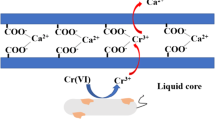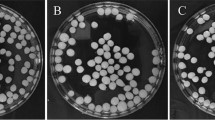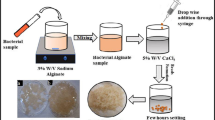Abstract
Cr(VI) was efficiently reduced to Cr(III) by Pannonibacter phragmitetus LSSE-09 encapsulated in liquid-core alginate–carboxymethyl cellulose capsules under alkaline conditions. Taking into account the physical properties of the capsules, the activity of encapsulated cells, and total Cr(III) concentration in the supernatant, optimal conditions (0.5% w/v sodium alginate; 2% w/v sodium carboxymethyl cellulose; 0.1 M CaCl2; 30-min gelation time) for LSSE-09 encapsulation were determined. At optimal conditions, a relatively high reduction rate of 4.20 mg g −1(dry weight) min−1 was obtained. Total Cr(III) concentration in the supernatant was significantly decreased after reduction, because 63.7% of the formed soluble organo-Cr(III) compounds compared with those of free cells were captured by the relatively smaller porous structure of alginate capsules. The optimal pH value (9.0) for Cr(VI) reduction was not changed after encapsulation. In addition, encapsulated LSSE-09 showed no appreciable loss in activity after eight repeated cycles at 37°C, and 85.7% of its initial activity remained after 35-day storage at 4°C. The results suggest that encapsulated LSSE-09 in alginate–carboxymethyl cellulose capsules has potential biotechnological applications for the detoxification of Cr(VI)-contaminated wastewater.










Similar content being viewed by others
References
Baral A, Engelken RD (2002) Chromium-based regulations and greening in metal finishing industries in the USA. Environ Sci Policy 5:121–133
Barnhart J (1997) Occurrences, uses, and proprties of chromium. Regul Toxicol Pharmacol 26:S3–S7
Blandino A, Macías M, Cantero D (1999) Formation of calcium alginate gel capsules: influence of sodium alginate and CaCl2 concentration on gelation kinetics. J Biosci Bioeng 88:686–689
Blandino A, Macías M, Cantero D (2000) Glucose oxidase release from calcium alginate gel capsules. Enzyme Microb Technol 27:319–324
Blandino A, Macías M, Cantero D (2001) Immobilization of glucose oxidase within calcium alginate gel capsules. Process Biochem 36:601–606
Bopp LH, Ehrlich HL (1988) Chromate resistance and reduction in Pseudomonas fluorescens strain LB300. Arch Microbiol 150:426–431
Bŭcko M, Vikartovská A, Lacík I, Kolláriková G, Gemeiner P, Pätoprstý V, Brygin M (2005) Immobilization of a whole-cell epoxide-hydrolyzing biocatalyst in sodium alginate-cellulose sulfate-poly (methylene-co-guanidine) capsules using a controlled encapsulation process. Enzyme Microb Technol 36:118–126
Campos J, Martinez-Pacheco M, Cervantes C (1995) Hexavalent-chromium reduction by a chromate-resistant Bacillus sp. strain. Anton Van Lee 68:203–208
Cassidy MB, Lee H, Trevors JT (1996) Environmental applications of immobilized microbial cells: a review. J Ind Microbiol 16:79–101
Cheong SH, Park JK, Kim BS, Chang HN (1993) Microencapsulation of yeast cells in the calcium alginate membrane. Biotechnol Tech 7:879–884
Costa M (2003) Potential hazards of hexavalent chromate in our drinking water. Toxicol Appl Pharmacol 188:1–5
Goosen MFA (1993) Biomedical application of immobilised cells. In: Goosen MFA (ed) Fundamentals of animal cell encapsulation and immobilization. CRC, Boca Raton
Greenberg AE, Trussell RR, Clesceri LS (1985) Standard methods for the examination of water and wastewater. APHA, New York
He Z, Gao F, Sha T, Hu Y, He C (2009) Isolation and characterization of a Cr(VI)-reduction Ochrobactrum sp. strain CSCr-3 from chromium landfill. J Hazard Mater 163:869–873
Hucík M, Bučko M, Gemeiner P, Štefuca V, Vikartovská A, Mihovilovič M, Rudroff F, Iqbal N, Chorvát D, Lacík I (2010) Encapsulation of recombinant E. coli expressing cyclopentanone monooxygenase in polyelectrolyte complex capsules for Baeyer–Villiger biooxidation of 8-oxabicyclo[3.2.1]oct-6-en-3-one. Biotechnol Lett 32:675–680
Humphries AC, Nott KP, Hall LD, Macaskie LE (2005) Reduction of Cr(VI) by immobilized cells of Desulfovibrio vulgaris NCIMB 8303 and Microbacterium sp. NCIMB 13776. Biotechnol Bioeng 90:589–596
Jiang Z, Zhang Y, Li J, Jiang W, Yang D, Wu H (2007) Encapsulation of β-glucuronidase in biomimetic alginate capsules for bioconversion of baicalin to baicalein. Ind Eng Chem Res 46:1883–1890
Kathiravan MN, Karthiga Rani R, Karthick R, Muthukumar K (2010) Mass transfer studies on the reduction of Cr(VI) using calcium alginate immobilized Bacillus sp. in packed bed reactor. Bioresour Technol 101:853–858
Koyama K, Seki M (2004) Cultivation of yeast and plant cells entrapped in the low-viscous liquid-core of an alginate membrane capsule prepared using polyethylene glycol. J Biosci Bioeng 97:111–118
Kratochvil D, Pimentel P, Volesky B (1998) Removal of trivalent and hexavalent chromium by seaweed biosorbent. Environ Sci Technol 32:2693–2698
Kuo CK, Ma PX (2001) Ionically crosslinked alginate hydrogels as scaffolds for tissue engineering: Part 1. Structure, gelation rate and mechanical properties. Biomaterials 22:511–521
Li Y, Xing J, Xiong X, Li W, Gao H, Liu H (2008) Improvement of biodesulfurization activity of alginate immobilized cells in biphasic systems. J Ind Microbiol Biotechnol 35:145–150
Llovera S, Bonet R, Simon-Pujol MD, Congregado F (1993) Chromate reduction by resting cells of Agrobacterium radiobacter EPS-916. Appl Environ Microbiol 59:3516–3518
McLean J, Beveridge TJ (2001) Chromate reduction by a Pseudomonad isolated from a site contaminated with chromated copper arsenate. Appl Environ Microbiol 67:1076–1084
Middleton SS, Latmani RB, Mackey MR, Ellisman MH, Tebo BM, Criddle CS (2003) Cometabolism of Cr(VI) by Shewanella oneidensis MR-1 produces cell-associated reduced chromium and inhibits growth. Biotechnol Bioeng 83:627–637
Moreno-Garrido I (2008) Microalgae immobilization: current techniques and uses. Bioresour Technol 99:3949–3964
Nigam SC, Tsao IF, Sakoda A, Wang HY (1988) Techniques for preparing hydrogel membrane capsules. Biotechnol Tech 2:271–276
Okutucu B, Çelem EB, Önal S (2010) Immobilization of α-galactosidase on galactose-containing polymeric beads. Enzyme Microb Technol 46:200–205
Pattanapipitpaisal P, Brown NL, Macaskie LE (2001) Chromate reduction by Microbacterium liquefaciens immobilised in polyvinyl alcohol. Biotechnol Lett 23:61–65
Patterson JW (1975) Wastewater treatment technology. Ann Arbor Science, New York
Peng Q, Liu Y, Zeng G, Xu W, Yang C, Zhang J (2010) Biosorption of copper (II) by immobilizing Saccharomyces cerevisiae on the surface of chitosan-coated magnetic nanoparticles from aqueous solution. J Hazard Mater 177:676–682
Puzon GJ, Roberts AG, Kramer DM, Xun L (2005) Formation of soluble organo-chromium(III) complexes after chromate reduction in the presence of cellular organics. Environ Sci Technol 39:2811–2817
Rai D, Sass BM, Moore DA (1987) Chromium(III) hydrolysis constants and solubility of chromium(III) hydroxide. Inorg Chem 26:345–349
Shen H, Wang YT (1993) Characterization of enzymatic reduction of hexavalent chromium by Escherichia coli ATCC 33456. Appl Environ Microbiol 59:3771–3777
SmidsrØd O, Skjåk-Bræk G (1990) Alginate as immobilization matrix for cells. Trends Biotechnol 8:71–78
Srivastava S, Thakur I (2007) Evaluation of biosorption potency of Acinetobacter sp. for removal of hexavalent chromium from tannery effluent. Biodegradation 18:637–646
Sultan S, Hasnain S (2007) Reduction of toxic hexavalent chromium by Ochrobactrum intermedium strain SDCr-5 stimulated by heavy metals. Bioresour Technol 98:340–344
Tanriseven A, Dogan S (2001) Immobilization of invertase within calcium alginate gel capsules. Process Biochem 36:1081–1083
Wang X, Gai Z, Yu B, Feng J, Xu C, Yuan Y, Lin Z, Xu P (2007) Degradation of carbazole by microbial cells immobilized in magnetic gellan gum gel beads. Appl Environ Microbiol 73:6421–6428
Xu L, Luo M, Li W, Wei X, Xie K, Liu L, Jiang C, Liu H (2011) Reduction of hexavalent chromium by Pannonibacter phragmitetus LSSE-09 stimulated with external electron donors under alkaline conditions. J Hazard Mater 185:1169–1176
Acknowledgments
This work was financially supported by the National Basic Research Program of China (No. 2007CB613507).
Author information
Authors and Affiliations
Corresponding author
Rights and permissions
About this article
Cite this article
Xu, L., Luo, M., Yang, L. et al. Encapsulation of Pannonibacter phragmitetus LSSE-09 in alginate–carboxymethyl cellulose capsules for reduction of hexavalent chromium under alkaline conditions. J Ind Microbiol Biotechnol 38, 1709–1718 (2011). https://doi.org/10.1007/s10295-011-0960-5
Received:
Accepted:
Published:
Issue Date:
DOI: https://doi.org/10.1007/s10295-011-0960-5




